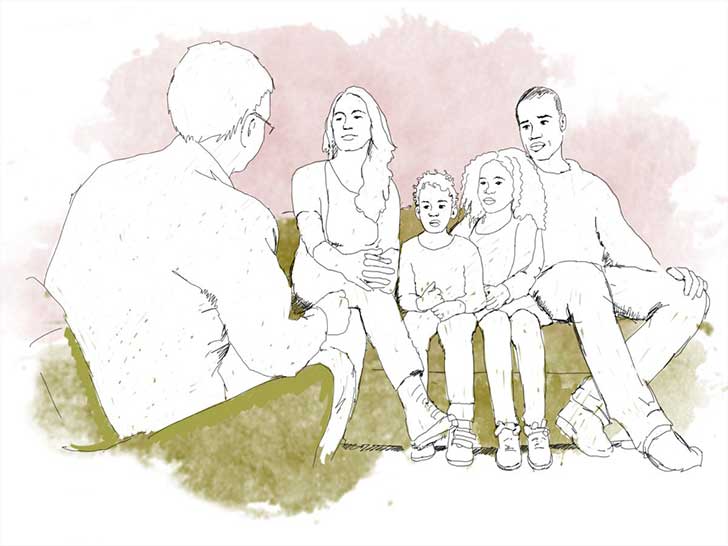اخبار روانشناسی ندای مهر
|
1
|
2
|
3
|
4
|
5
|
6
|
7
|
|
not at all
true
|
somewhat
true
|
very
true
|
|
1
|
2
|
3
|
4
|
5
|
6
|
7
|
|
not at all
true
|
somewhat
true
|
very
true
|
|
1
|
2
|
3
|
4
|
5
|
6
|
7
|
|
not at all
true
|
somewhat
true
|
very
true
|
Ryan‚ R. M.‚ & Deci‚ E. L. (2000). Self-determination theory and the facilitation of intrinsic motivation‚ social development‚ and well-being. American Psychologist‚ 55‚ 68-78
|
|
||||||||||||||
|
The Self-Regulation Questionnaires
Religious Self-Regulation Questionnaire (SRQ-R)
Also called Christian Religious Internalization Scale (CRIS)
This questionnaire concerns the reasons why a person engages in religious behaviors. The questions were written for research with a Christian population‚ but could be easily adapted for other religions. The questionnaire asks why people engage in four religious behaviors‚ each of which is followed by three reasons.
In all‚ there are 12 items on the SRQ-R. The questionnaire was developed and validated by Ryan‚ Rigby‚ and King‚ (1993). There is a long form of the questionnaire with 48 items‚ but analyses revealed that the current 12-item version is as psychometrically sound as the longer version and is far more economical. The scale has only two subscales: Introjected Regulation and Identified Regulation. Work with the longer scale revealed that these two subscales represented the dynamically meaningful reasons why people engage in religious behaviors and that the external regulation and intrinsic motivation subscales did not add to the validity of the scale. Below is the actual scale‚ followed by information about scoring.
The Scale
Religious Behaviors
This questionnaire has four statements‚ each of which is followed by three possible responses. Please read the
first statement‚ and then consider each response. Indicate how true each response is for you‚ using the following scale.
A. One reason I think it’s important to actively share my faith with others is:
1. Because God is important to me and I’d like other people to know about Him too.
2. Because I would feel bad about myself if I didn’t.
3. Because I want other Christians to approve of me.
B. When I turn to God‚ I most often do it because:
4. I enjoy spending time with Him.
5. I would feel guilty if I didn’t.
6. I find it is satisfying to me.
C. A reason I think praying by myself is important is:
7. Because if I don’t‚ God will disapprove of me.
8. Because I enjoy praying.
9. Because I find prayer satisfying.
D. An important reason why I attend church is:
10. Because one is supposed to go to church.
11. By going to church I learn new things.
12. Because others would disapprove of me if I didn’t.
Validation article
Ryan‚ R. M.‚ Rigby‚ S.‚ & King‚ K. (1993). Two types of religious internalization and their relations to religious orientations and mental health. Journal of Personality and Social Psychology‚ 65‚ 586-596.
The SRQ-R is reviewed and reproduced in
Hill‚P. C.‚ & Hood‚ R. W.‚ Jr. (Eds.) (1999). Measures of religiosity (pp. 124-127). Birmingham‚ AL: Religious Education Press.
|
|
|
|||
|
HAMILTON DEPRESSION RATING SCALE (HAM-D)
(To be administered by a health care professional)
Patient Name _________________________________________ Today’s Date __________________
The HAM-D is designed to rate the severity of depression in patients. Although it contains 21 areas‚ calculate the patient’s score on the first 17 answers.
1. DEPRESSED MOOD
(Gloomy attitude‚ pessimism about the future‚ feeling of sadness‚ tendency to weep)
0 = Absent
1 = Sadness‚ etc.
2 = Occasional weeping
3 = Frequent weeping
4 = Extreme symptoms
2. FEELINGS OF GUILT
0 = Absent
1 = Self-reproach‚ feels he/she has let people down
2 = Ideas of guilt
3 = Present illness is a punishment; delusions of guilt
4 = Hallucinations of guilt
3. SUICIDE
0 = Absent
1 = Feels life is not worth living
2 = Wishes he/she were dead
3 = Suicidal ideas or gestures
4 = Attempts at suicide
4. INSOMNIA - Initial
(Difficulty in falling asleep)
0 = Absent
1 = Occasional
2 = Frequent
5. INSOMNIA - Middle
(Complains of being restless and disturbed during the night. Waking during the night.)
0 = Absent
1 = Occasional
2 = Frequent
6. INSOMNIA - Delayed
(Waking in early hours of the morning and unable to fall asleep again)
0 = Absent
1 = Occasional
2 = Frequent
7. WORK AND INTERESTS
0 = No difficulty
1 = Feelings of incapacity‚ listlessness‚ indecision and vacillation
2 = Loss of interest in hobbies‚ decreased social activities
3 = Productivity decreased
4 = Unable to work. Stopped working because of present illness only. (Absence from work after treatment or recovery may rate a lower score).
8. RETARDATION
(Slowness of thought‚ speech‚ and activity; apathy; stupor.)
0 = Absent
1 = Slight retardation at interview
2 = Obvious retardation at interview
3 = Interview difficult
4 = Complete stupor
9. AGITATION
(Restlessness associated with anxiety.)
0 = Absent
1 = Occasional
2 = Frequent
10. ANXIETY - PSYCHIC
0 = No difficulty
1 = Tension and irritability
2 = Worrying about minor matters
3 = Apprehensive attitude
4 = Fears
11. ANXIETY - SOMATIC
Gastrointestinal‚ indigestion Cardiovascular‚ palpitation‚ Headaches Respiratory‚ Genito-urinary‚ etc.
0 = Absent
1 = Mild
2 = Moderate
3 = Severe
4 = Incapacitating
12. SOMATIC SYMPTOMS - GASTROINTESTINAL
(Loss of appetite ‚ heavy feeling in abdomen; constipation)
0 = Absent
1 = Mild
2 = Severe
13. SOMATIC SYMPTOMS - GENERAL
(Heaviness in limbs‚ back or head; diffuse backache; loss of energy and fatiguability)
0 = Absent
1 = Mild
2 = Severe
14. GENITAL SYMPTOMS
(Loss of libido‚ menstrual disturbances)
0 = Absent
1 = Mild
2 = Severe
15. HYPOCHONDRIASIS
0 = Not present
1 = Self-absorption (bodily)
2 = Preoccupation with health
3 = Querulous attitude
4 = Hypochondriacal delusions
16. WEIGHT LOSS
0 = No weight loss
1 = Slight
2 = Obvious or severe
17. INSIGHT
(Insight must be interpreted in terms of patient’s understanding and background.)
0 = No loss
1 = Partial or doubtfull loss
2 = Loss of insight
TOTAL ITEMS 1 TO 17: _______________
0 - 7 = Normal
8 - 13 = Mild Depression
14-18 = Moderate Depression
19 - 22 = Severe Depression
> 23 = Very Severe Depression
18. DIURNAL VARIATION
(Symptoms worse in morning or evening. Note which it is. )
0 = No variation
1 = Mild variation; AM ( ) PM ( )
2 = Severe variation; AM ( ) PM ( )
19. DEPERSONALIZATION AND DEREALIZATION
(feelings of unreality‚ nihilistic ideas)
0 = Absent
1 = Mild
2 = Moderate
3 = Severe
4 = Incapacitating
20. PARANOID SYMPTOMS
(Not with a depressive quality)
0 = None
1 = Suspicious
2 = Ideas of reference
3 = Delusions of reference and persecution
4 = Hallucinations‚ persecutory
21. OBSESSIONAL SYMPTOMS
(Obsessive thoughts and compulsions against
which the patient struggles)
0 = Absent
1 = Mild
2 = Severe
* Adapted from Hamilton‚ M. Journal of Neurology‚ Neurosurgery‚ and Psychiatry. 23:56-62‚ 1960.
|
|
1
|
2
|
3
|
4
|
5
|
6
|
7
|
|
not at all
true
|
somewhat
true
|
very
true
|
The Scale (12-vignette version)
These items pertain to a series of hypothetical sketches. Each sketch describes an incident and lists three ways of responding to it. Please read each sketch‚ imagine yourself in that situation‚ and then consider each of the possible responses. Think of each response option in terms of how likely it is that you would respond that way. (We all respond in a variety of ways to situations‚ and probably most or all responses are at least slightly likely for you.) If it is very unlikely that you would respond the way described in a given response‚ you should circle answer 1 or 2. If it is moderately likely‚ you would select a number in the mid range‚ and if it is very likely that you would respond as described‚ you would circle answer 6 or 7.
1. You have been offered a new position in a company where you have worked for some time. The first question that is likely to come to mind is:
a) What if I can't live up to the new responsibility?
|
1 |
2 |
3 |
4 |
5 |
6 |
7 |
|
very unlikely |
|
|
moderately likely |
|
|
very likely |
b) Will I make more at this position?
|
1 |
2 |
3 |
4 |
5 |
6 |
7 |
|
very unlikely |
|
|
moderately likely |
|
|
very likely |
|
1 |
2 |
3 |
4 |
5 |
6 |
7 |
|
very unlikely |
|
|
moderately likely |
|
|
very likely |
|
1 |
2 |
3 |
4 |
5 |
6 |
7 |
|
very unlikely |
|
|
moderately likely |
|
|
very likely |
|
1 |
2 |
3 |
4 |
5 |
6 |
7 |
|
very unlikely |
|
|
moderately likely |
|
|
very likely |
|
1 |
2 |
3 |
4 |
5 |
6 |
7 |
|
very unlikely |
|
|
moderately likely |
|
|
very likely |
|
1 |
2 |
3 |
4 |
5 |
6 |
7 |
|
very unlikely |
|
|
moderately likely |
|
|
very likely |
|
1 |
2 |
3 |
4 |
5 |
6 |
7 |
|
very unlikely |
|
|
moderately likely |
|
|
very likely |
|
1 |
2 |
3 |
4 |
5 |
6 |
7 |
|
very unlikely |
|
|
moderately likely |
|
|
very likely |
|
1 |
2 |
3 |
4 |
5 |
6 |
7 |
|
very unlikely |
|
|
moderately likely |
|
|
very likely |
|
1 |
2 |
3 |
4 |
5 |
6 |
7 |
|
very unlikely |
|
|
moderately likely |
|
|
very likely |
|
1 |
2 |
3 |
4 |
5 |
6 |
7 |
|
very unlikely |
|
|
moderately likely |
|
|
very likely |
|
1 |
2 |
3 |
4 |
5 |
6 |
7 |
|
very unlikely |
|
|
moderately likely |
|
|
very likely |
|
1 |
2 |
3 |
4 |
5 |
6 |
7 |
|
very unlikely |
|
|
moderately likely |
|
|
very likely |
|
1 |
2 |
3 |
4 |
5 |
6 |
7 |
|
very unlikely |
|
|
moderately likely |
|
|
very likely |
|
1 |
2 |
3 |
4 |
5 |
6 |
7 |
|
very unlikely |
|
|
moderately likely |
|
|
very likely |
|
1 |
2 |
3 |
4 |
5 |
6 |
7 |
|
very unlikely |
|
|
moderately likely |
|
|
very likely |
|
1 |
2 |
3 |
4 |
5 |
6 |
7 |
|
very unlikely |
|
|
moderately likely |
|
|
very likely |
|
1 |
2 |
3 |
4 |
5 |
6 |
7 |
|
very unlikely |
|
|
moderately likely |
|
|
very likely |
|
1 |
2 |
3 |
4 |
5 |
6 |
7 |
|
very unlikely |
|
|
moderately likely |
|
|
very likely |
|
1 |
2 |
3 |
4 |
5 |
6 |
7 |
|
very unlikely |
|
|
moderately likely |
|
|
very likely |
|
1 |
2 |
3 |
4 |
5 |
6 |
7 |
|
very unlikely |
|
|
moderately likely |
|
|
very likely |
|
1 |
2 |
3 |
4 |
5 |
6 |
7 |
|
very unlikely |
|
|
moderately likely |
|
|
very likely |
|
1 |
2 |
3 |
4 |
5 |
6 |
7 |
|
very unlikely |
|
|
moderately likely |
|
|
very likely |
|
1 |
2 |
3 |
4 |
5 |
6 |
7 |
|
very unlikely |
|
|
moderately likely |
|
|
very likely |
|
1 |
2 |
3 |
4 |
5 |
6 |
7 |
|
very unlikely |
|
|
moderately likely |
|
|
very likely |
|
1 |
2 |
3 |
4 |
5 |
6 |
7 |
|
very unlikely |
|
|
moderately likely |
|
|
very likely |
|
1 |
2 |
3 |
4 |
5 |
6 |
7 |
|
very unlikely |
|
|
moderately likely |
|
|
very likely |
|
1 |
2 |
3 |
4 |
5 |
6 |
7 |
|
very unlikely |
|
|
moderately likely |
|
|
very likely |
|
1 |
2 |
3 |
4 |
5 |
6 |
7 |
|
very unlikely |
|
|
moderately likely |
|
|
very likely |
|
1 |
2 |
3 |
4 |
5 |
6 |
7 |
|
very unlikely |
|
|
moderately likely |
|
|
very likely |
|
1 |
2 |
3 |
4 |
5 |
6 |
7 |
|
very unlikely |
|
|
moderately likely |
|
|
very likely |
|
1 |
2 |
3 |
4 |
5 |
6 |
7 |
|
very unlikely |
|
|
moderately likely |
|
|
very likely |
|
1 |
2 |
3 |
4 |
5 |
6 |
7 |
|
very unlikely |
|
|
moderately likely |
|
|
very likely |
|
1 |
2 |
3 |
4 |
5 |
6 |
7 |
|
very unlikely |
|
|
moderately likely |
|
|
very likely |
|
1 |
2 |
3 |
4 |
5 |
6 |
7 |
|
very unlikely |
|
|
moderately likely |
|
|
very likely |
|
|
|||
|
Suicide Measure Author Address
Adult Suicidal Ideation Questionnaire
Reynolds‚ WilliamM.
William M. Reynolds
University of British Columbia Department of Education
Psychology
2125 Main Mallnue
Vancouver‚ BC V6T I24
این آدرس ایمیل توسط spambots حفاظت می شود. برای دیدن شما نیاز به جاوا اسکریپت دارید
Beck Hopelessness Scale Beck‚ Aaron T. Psychological Corporation 555 Academic Court
San Antonio‚ TX 78204
Attn: Clinical Sales
1-800-211-8378
Beck Scale for Suicide
Ideation
Beck‚ Aaron T. Aaron T. Beck
University of Pennsylvania
The Science Center‚ Room 754
3600 Market Street
Philadelphia‚ PA 19104-2648
این آدرس ایمیل توسط spambots حفاظت می شود. برای دیدن شما نیاز به جاوا اسکریپت دارید
Brief Reasons for Living Inventory
Ivanoff‚ Andre Andre Ivanoff
Columbia University
School of Social Work
704 McVickar Hall
622 West 113th. Street New York‚ NY 10025
این آدرس ایمیل توسط spambots حفاظت می شود. برای دیدن شما نیاز به جاوا اسکریپت دارید
College Students Reasons for Living Inventory Westefeld‚ John S. John S. Westefeld Department of Psychological and Quantitative Foundations
University of Iowa
Iowa City‚ Iowa 52242
این آدرس ایمیل توسط spambots حفاظت می شود. برای دیدن شما نیاز به جاوا اسکریپت دارید
Firestone Assessment of Self-Destructive Thoughts Firestone‚ Robert W. Robert W. Firestone The Glendon Association
5383 Hollister Ave.‚ Suite 230 Santa Barbara‚ CA 93111
این آدرس ایمیل توسط spambots حفاظت می شود. برای دیدن شما نیاز به جاوا اسکریپت دارید
Lethality Scale Beck‚ Aaron T. Aaron T. Beck University of Pennsylvania
The Science Center‚ Room 754
3600 Market Street
Philadelphia‚ PA 19104-2648
این آدرس ایمیل توسط spambots حفاظت می شود. برای دیدن شما نیاز به جاوا اسکریپت دارید
Suicide Assessment 54
Lifetime Parasuicide Count
Linehan‚ Marsha M. Marsha M. Linehan Behavioral Research & Therapy Clinics Department of Psychology‚ Box 351525
University of Washington
Seattle‚ Washington 98195
این آدرس ایمیل توسط spambots حفاظت می شود. برای دیدن شما نیاز به جاوا اسکریپت دارید
Linehan Reasons for Living Inventory Linehan‚ Marsha M. Marsha M. Linehan Behavioral Research & Therapy Clinics Department of Psychology‚ Box 351525
University of Washington
Seattle‚ Washington 98195
این آدرس ایمیل توسط spambots حفاظت می شود. برای دیدن شما نیاز به جاوا اسکریپت دارید
Modified Scale for Suicide Ideation Miller‚ Ivan W. Ivan W. Miller Box G-RI
Brown University
Providence‚ RI 02912-G-RI
Paykel Suicide Scale Paykel‚ E.S. E.S. Paykel University of Cambridge
Department of Psychiatry
Addenbrooke’s Hospital
Cambridge‚ CB2 2AA
ENGLAND
Parasuicide History Inventory
Linehan‚ Marsha M. Marsha M. Linehan Behavioral Research & Therapy Clinics Department of Psychology‚ Box 351525
University of Washington
Seattle‚ Washington 98195
این آدرس ایمیل توسط spambots حفاظت می شود. برای دیدن شما نیاز به جاوا اسکریپت دارید
Quiz on Depression and Suicide in Later Life Pratt‚ C.C. C.C. Pratt
Department of Human Development and Family Studies
Oregon State University
Corvallis‚ OR 97331-5102
SAD Persons Scale Patterson‚ W.M. W.M. Patterson Smolian Clinic
Room 210
Department of Psychiatry
University Station
Birmingham‚ AL 15294
Scale for Suicide Ideation Beck‚ Aaron T. Aaron T. Beck University of Pennsylvania
The Science Center‚ Room 754
3600 Market Street
Philadelphia‚ PA 19104-2648
این آدرس ایمیل توسط spambots حفاظت می شود. برای دیدن شما نیاز به جاوا اسکریپت دارید
Scale for Suicide Ideation-Worst
Beck‚ Aaron T. Aaron T. Beck
University of Pennsylvania
The Science Center‚ Room 754
3600 Market Street
Philadelphia‚ PA 19104-2648
این آدرس ایمیل توسط spambots حفاظت می شود. برای دیدن شما نیاز به جاوا اسکریپت دارید
Self-Inflicted Injury Severity Form Potter‚ Lloyd Lloyd Potter
Centers for Disease Control and Prevention
National Center for Injury
Prevention and Control
4770 Buford Highway‚ N.E.
Mailstop K-60
Atlanta‚ GA 30341
Self-Monitoring Suicide Ideation Scale Clum‚ George A. George A. Clum Psychology
5093G Derring Hall
Blacksburg‚ VA 24061
این آدرس ایمیل توسط spambots حفاظت می شود. برای دیدن شما نیاز به جاوا اسکریپت دارید
Suicidal Behaviors Interview
Ivanoff‚ Andre Andre Ivanoff
Columbia University
School of Social Work
704 McVickar Hall
622 West 113th. Street New York‚ NY 10025
این آدرس ایمیل توسط spambots حفاظت می شود. برای دیدن شما نیاز به جاوا اسکریپت دارید
Suicide Behaviors Questionnaire
Linehan‚ Marsha M. Marsha M. Linehan Behavioral Research & Therapy Clinics Department of Psychology‚ Box 351525
University of Washington
Seattle‚ Washington 98195
این آدرس ایمیل توسط spambots حفاظت می شود. برای دیدن شما نیاز به جاوا اسکریپت دارید
Suicide Ideation Scale Rudd‚ M. David David Rudd Professor of Psychology
Department of Psychology
Baylor University
P.O. Box 97334
Waco. TX 76798-7334
این آدرس ایمیل توسط spambots حفاظت می شود. برای دیدن شما نیاز به جاوا اسکریپت دارید
Suicidal Ideation Screening Questionnaire Cooper-Patrick‚ Lisa Lisa Cooper-Patrick Welch Center for Prevention‚
Epidemiology and Clinical Research 2024 E. Monument St.‚ Suite 2-600 Baltimore‚ MD 21205-2223
Suicide Intent Scale Beck‚ Aaron T. Aaron T. Beck University of Pennsylvania
The Science Center‚ Room 754
3600 Market Street
Philadelphia‚ PA 19104-2648
این آدرس ایمیل توسط spambots حفاظت می شود. برای دیدن شما نیاز به جاوا اسکریپت دارید
Suicide Intervention Response Inventory Neimeyer‚ Robert A. Robert A. Neimeyer Department of Psychiatry
Clinical Sciences Center
600 Highland Ave.
Madison‚ WI 53792
Suicide Intervention
Response Inventory –2
Neimeyer‚ Robert A. Robert A. Neimeyer Department of Psychiatry
Clinical Sciences Center
600 Highland Ave.
Madison‚ WI 53792
Suicide Opinion Questionnaire
Domino‚ George George Domino
Department of Psychology
University of Arizona
Tucson‚ AZ 85721
Suicide Potential Lethality Scale
Holmes‚ Cooper B. Cooper B. Holmes Department of Psychology
Emporial SU
1200 Commercial
Emporia‚ KS 66801
Journal of Consulting & Clinical Psychology‚ 48‚ 383-387
Suicide Probability Scale Cull‚ J.G. & Gill‚ W.S. Western Psychological Services Publishers and Distributors
12031 Wilshire Boulevard
Los Angeles‚ CA 90025-1251
Suicide Status Form Jobes‚ David A. David A. Jobes Catholic University
Department of Psychology
Washington‚ DC 20064
این آدرس ایمیل توسط spambots حفاظت می شود. برای دیدن شما نیاز به جاوا اسکریپت دارید |
|
1
|
2
|
3
|
4
|
5
|
6
|
7
|
|
very unlikely
|
moderately likely
|
very likely
|
|
1
|
2
|
3
|
4
|
5
|
6
|
7
|
|
very unlikely
|
moderately likely
|
very likely
|
|
1
|
2
|
3
|
4
|
5
|
6
|
7
|
|
very unlikely
|
moderately likely
|
very likely
|
|
1
|
2
|
3
|
4
|
5
|
6
|
7
|
|
very unlikely
|
moderately likely
|
very likely
|
|
1
|
2
|
3
|
4
|
5
|
6
|
7
|
|
very unlikely
|
moderately likely
|
very likely
|
|
1
|
2
|
3
|
4
|
5
|
6
|
7
|
|
very unlikely
|
moderately likely
|
very likely
|
|
1
|
2
|
3
|
4
|
5
|
6
|
7
|
|
very unlikely
|
moderately likely
|
very likely
|
|
1
|
2
|
3
|
4
|
5
|
6
|
7
|
|
very unlikely
|
moderately likely
|
very likely
|
|
1
|
2
|
3
|
4
|
5
|
6
|
7
|
|
very unlikely
|
moderately likely
|
very likely
|
|
1
|
2
|
3
|
4
|
5
|
6
|
7
|
|
very unlikely
|
moderately likely
|
very likely
|
|
1
|
2
|
3
|
4
|
5
|
6
|
7
|
|
very unlikely
|
moderately likely
|
very likely
|
|
1
|
2
|
3
|
4
|
5
|
6
|
7
|
|
very unlikely
|
moderately likely
|
very likely
|
|
1
|
2
|
3
|
4
|
5
|
6
|
7
|
|
very unlikely
|
moderately likely
|
very likely
|
|
1
|
2
|
3
|
4
|
5
|
6
|
7
|
|
very unlikely
|
moderately likely
|
very likely
|
|
1
|
2
|
3
|
4
|
5
|
6
|
7
|
|
very unlikely
|
moderately likely
|
very likely
|
|
1
|
2
|
3
|
4
|
5
|
6
|
7
|
|
very unlikely
|
moderately likely
|
very likely
|
|
1
|
2
|
3
|
4
|
5
|
6
|
7
|
|
very unlikely
|
moderately likely
|
very likely
|
|
1
|
2
|
3
|
4
|
5
|
6
|
7
|
|
very unlikely
|
moderately likely
|
very likely
|
|
1
|
2
|
3
|
4
|
5
|
6
|
7
|
|
very unlikely
|
moderately likely
|
very likely
|
|
1
|
2
|
3
|
4
|
5
|
6
|
7
|
|
very unlikely
|
moderately likely
|
very likely
|
|
1
|
2
|
3
|
4
|
5
|
6
|
7
|
|
very unlikely
|
moderately likely
|
very likely
|
|
1
|
2
|
3
|
4
|
5
|
6
|
7
|
|
very unlikely
|
moderately likely
|
very likely
|
|
1
|
2
|
3
|
4
|
5
|
6
|
7
|
|
very unlikely
|
moderately likely
|
very likely
|
|
1
|
2
|
3
|
4
|
5
|
6
|
7
|
|
very unlikely
|
moderately likely
|
very likely
|
|
1
|
2
|
3
|
4
|
5
|
6
|
7
|
|
very unlikely
|
moderately likely
|
very likely
|
|
1
|
2
|
3
|
4
|
5
|
6
|
7
|
|
very unlikely
|
moderately likely
|
very likely
|
|
1
|
2
|
3
|
4
|
5
|
6
|
7
|
|
very unlikely
|
moderately likely
|
very likely
|
|
1
|
2
|
3
|
4
|
5
|
6
|
7
|
|
very unlikely
|
moderately likely
|
very likely
|
|
1
|
2
|
3
|
4
|
5
|
6
|
7
|
|
very unlikely
|
moderately likely
|
very likely
|
|
1
|
2
|
3
|
4
|
5
|
6
|
7
|
|
very unlikely
|
moderately likely
|
very likely
|
|
1
|
2
|
3
|
4
|
5
|
6
|
7
|
|
very unlikely
|
moderately likely
|
very likely
|
|
1
|
2
|
3
|
4
|
5
|
6
|
7
|
|
very unlikely
|
moderately likely
|
very likely
|
|
1
|
2
|
3
|
4
|
5
|
6
|
7
|
|
very unlikely
|
moderately likely
|
very likely
|
|
1
|
2
|
3
|
4
|
5
|
6
|
7
|
|
very unlikely
|
moderately likely
|
very likely
|
|
1
|
2
|
3
|
4
|
5
|
6
|
7
|
|
very unlikely
|
moderately likely
|
very likely
|
|
1
|
2
|
3
|
4
|
5
|
6
|
7
|
|
very unlikely
|
moderately likely
|
very likely
|
|
1
|
2
|
3
|
4
|
5
|
6
|
7
|
|
very unlikely
|
moderately likely
|
very likely
|
|
1
|
2
|
3
|
4
|
5
|
6
|
7
|
|
very unlikely
|
moderately likely
|
very likely
|
|
1
|
2
|
3
|
4
|
5
|
6
|
7
|
|
very unlikely
|
moderately likely
|
very likely
|
|
1
|
2
|
3
|
4
|
5
|
6
|
7
|
|
very unlikely
|
moderately likely
|
very likely
|
|
1
|
2
|
3
|
4
|
5
|
6
|
7
|
|
very unlikely
|
moderately likely
|
very likely
|
|
1
|
2
|
3
|
4
|
5
|
6
|
7
|
|
very unlikely
|
moderately likely
|
very likely
|
|
1
|
2
|
3
|
4
|
5
|
6
|
7
|
|
very unlikely
|
moderately likely
|
very likely
|
|
1
|
2
|
3
|
4
|
5
|
6
|
7
|
|
very unlikely
|
moderately likely
|
very likely
|
|
1
|
2
|
3
|
4
|
5
|
6
|
7
|
|
very unlikely
|
moderately likely
|
very likely
|
|
1
|
2
|
3
|
4
|
5
|
6
|
7
|
|
very unlikely
|
moderately likely
|
very likely
|
|
1
|
2
|
3
|
4
|
5
|
6
|
7
|
|
very unlikely
|
moderately likely
|
very likely
|
|
1
|
2
|
3
|
4
|
5
|
6
|
7
|
|
very unlikely
|
moderately likely
|
very likely
|
|
1
|
2
|
3
|
4
|
5
|
6
|
7
|
|
very unlikely
|
moderately likely
|
very likely
|
|
1
|
2
|
3
|
4
|
5
|
6
|
7
|
|
very unlikely
|
moderately likely
|
very likely
|
|
1
|
2
|
3
|
4
|
5
|
6
|
7
|
|
very unlikely
|
moderately likely
|
very likely
|

-

-

تاثیرات منفی اشتغال زنان بر روابط خانواده
کارشناس ندای مهر (مشاوره خانواده) -

معجون معجزه آسا برای ایجاد صمیمیت بین همسران در خانواده
کارشناس ندای مهر (مشاوره خانواده) -

برای مراجعه به مشاوره خانواده آیا باید مریض و یا آشفته باشم؟
کارشناس ندای مهر (مشاوره خانواده) -

چرا به مشاوره خانواده مراجعه کنیم و به وی پول بدهیم؟
کارشناس ندای مهر (مشاوره خانواده)





